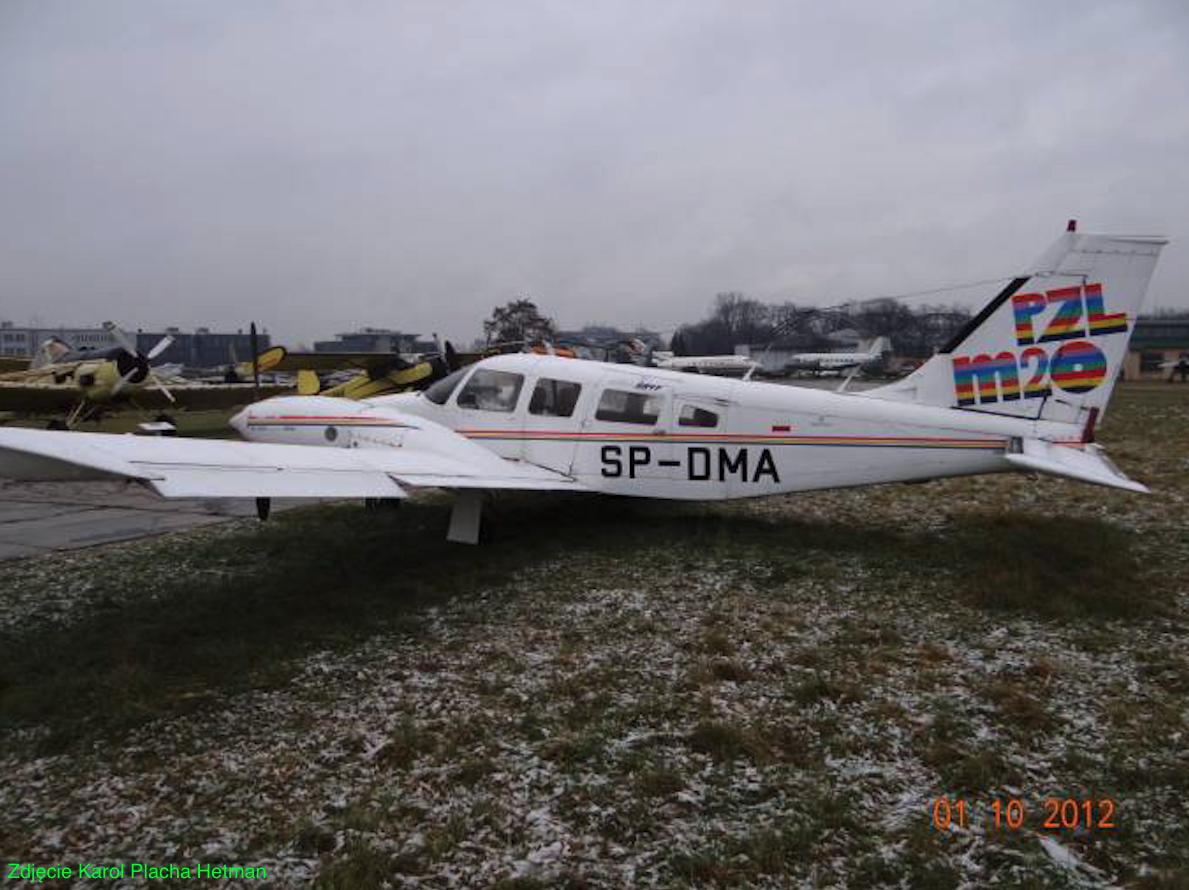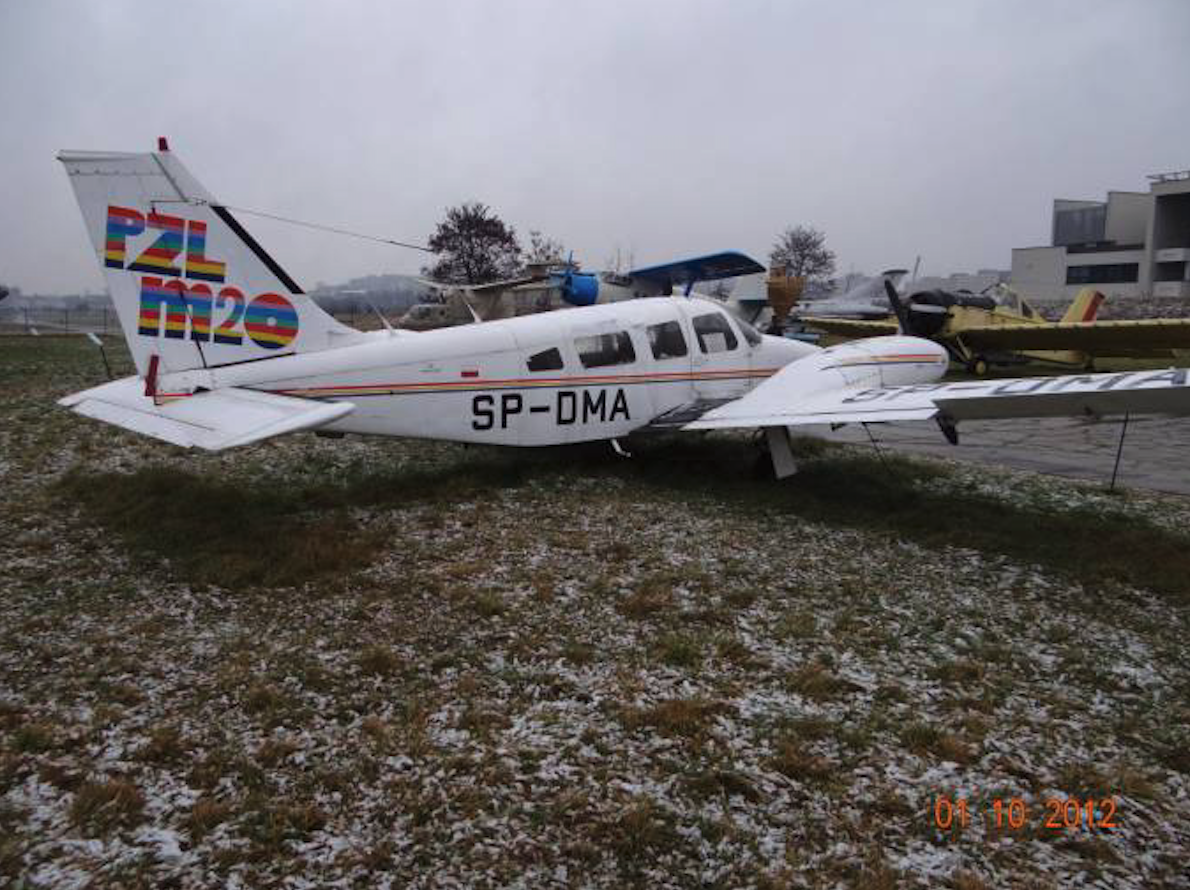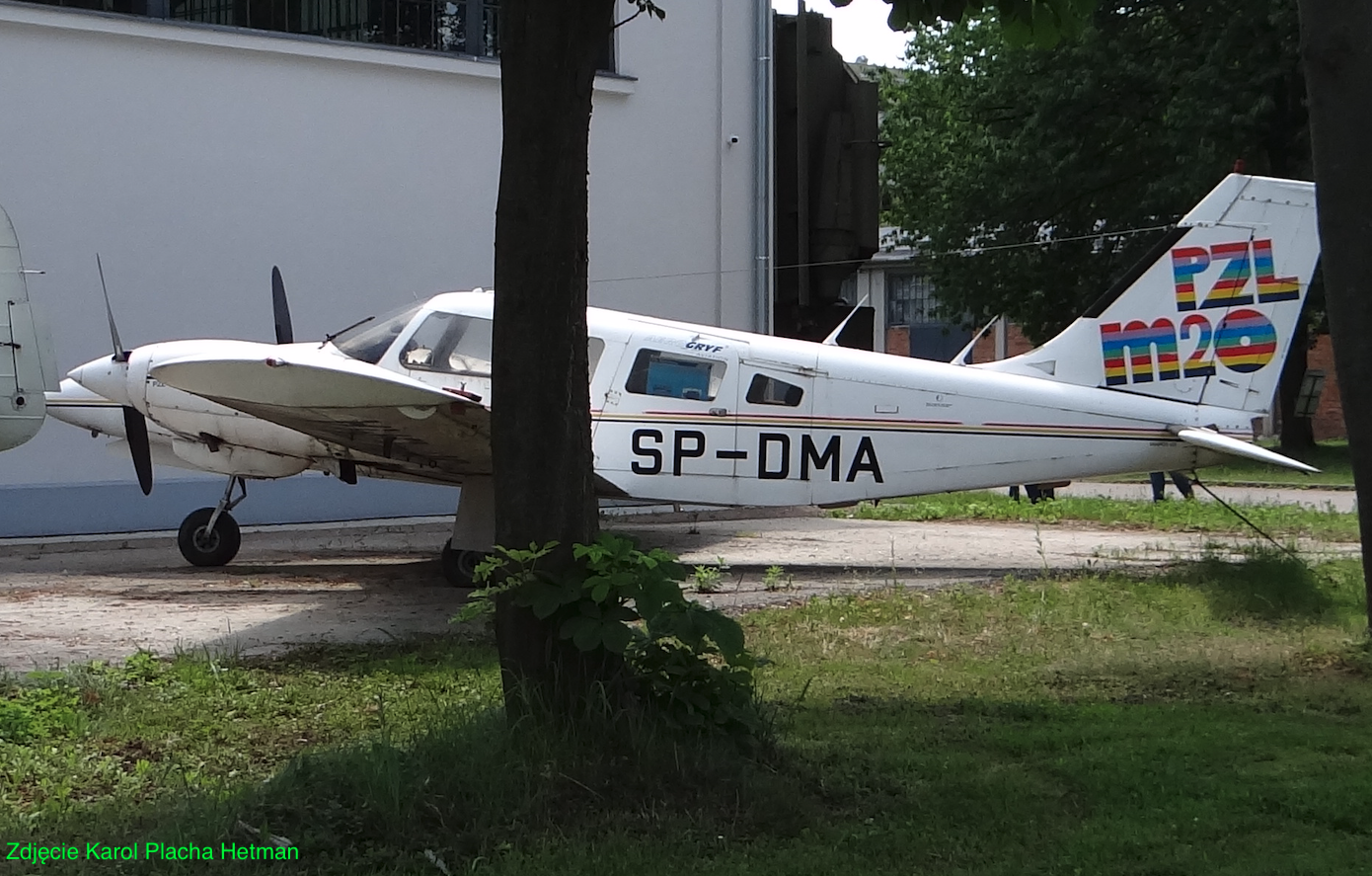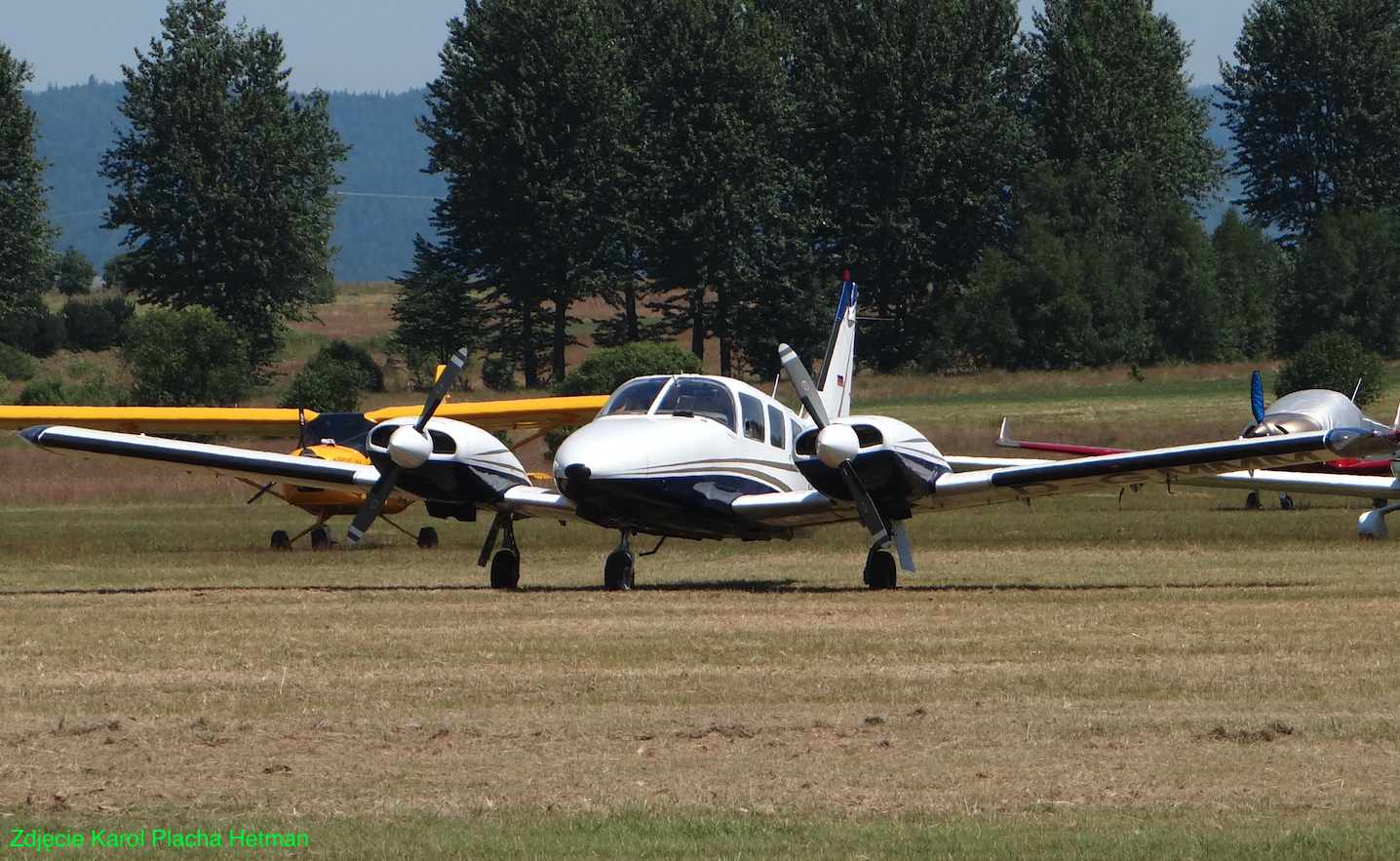Kraków 2012-07-22
PZL-Mielec M-20 Mewa / Piper PA-34 Seneca II. Część 3.
255b Section 25.07.1979 year. Poland.
PZL M-20 Mewa is a disposable aircraft produced in PZL Mielec.
Construction.
The aircraft is an all-metal twin-engine low-wing monoplane. Some elements are made of laminate (e.g. covers). The plane takes 6-7 people on board. It can use airfields from RWY with ground (grass) surface.
Rectangular wings. The rake of the leading edge is 0 degrees. Only at the root of the wing, small inflows were added. NACA 652415 profile, positive rise of 7 degrees, two-piece, single-girder, shell, metal construction. 11 basic frames were mounted to the girder, and stringers to them. Frize ailerons, slotted flaps, 4-position. Pneumatic anti-icing system on the noses. Moving the control surfaces with the help of cables. Hydraulically hinged flaps. There are 6 discharge prongs on the trailing edge of the wings. In the wings, in front of the main spar, there are fuel tanks. This part of the wings is made as airtight. Nacelles with engines are mounted to the wings. Fire barriers were placed between the engine nacelles and the wings. The wings provide excellent flying conditions.
The fuselage of the aircraft is of semi-monocoque construction, unified with earlier Piper aircraft. The base is 11 frames connected by stringers. Unpressurized, ventilated and heated cabin. It accommodates 6-7 people. As standard, the M-20 takes a pilot and 5 passengers on board. The sanitary version takes the pilot, a patient on a stretcher and two medical staff. Classically equipped with one controls, but there are copies with double controls (those used for flight training). The cabin is accessed via two doors that open outwards. Pilots board through the door located on the starboard side above the wing. Passengers board through the door located on the left side behind the wing. As standard, the cabin was equipped with 6 individual seats. Each seat is equipped with lap belts. At the customer’s request, three-point car-type seat belts can be installed. Above each seat there is a lamp and an air vent. Originally, all seats were forward-facing. Then the second row of seats were set backwards to the direction of flight, which provides more legroom. The seats are of a soft type, upholstered in artificial leather. There is a large trunk behind the cabin. In the front part of the fuselage, in addition to the equipment (batteries), there is also a large trunk. The cabin is richly glazed. The wind deflector consists of two windows and provides good visibility. The window in front of the pilot (left) additionally has a rectangular viewfinder, which is heated. The other windows were placed on the port and starboard sides.
Classic tail. The vertical tail is divided into rudder and stabilizer. The rudder is equipped with a trim tab. Horizontal plate, one-piece with balancing flap. Pneumatic anti-icing system in the leading edges. On the trailing tail, there are 3 discharging mustaches of electrostatic charges.
The plate horizontal tail used in an aircraft with a cruising speed of about 340 km/h is an extremely rare solution.
Three-support aircraft landing gear with a front wheel, fully retractable in flight. Hydraulically retractable, telescopic legs, hydraulic disc brakes on the main wheels, oil-gas shock absorption. Two-piece front undercarriage compartment covers. Main landing gear covers incomplete with one cover.
Avionics and equipment.
The aircraft was equipped with Bendix/King Silver Crown avionics. Instrument sets VFR/IFR, VOR/LOC, ADF, transponder. HF and UHF band radio station. The aircraft is equipped with complete external lighting, including flashing lights. The aircraft has; electrical installations, hydraulic installations (moves the flaps, retracts and extends the landing gear), ventilation, heating and air conditioning installations.
Engines.
2 Teledyne Continental TSIO-360KB and LTSIO-360KB 6-cylinder engines (opposite direction of rotation).
Or 2 6-cylinder engines PZL-Franklin 6A-350C1L left and 6A-350C1R(A) right (opposite direction of rotation) 2 x 164 kW (2 x 220 HP).
Hartzell BHC-C2YF-2CKUF and BHC-C2YF-2CLKUF constant speed two-blade propellers. It is worth noting that Seneca II-V aircraft mainly use 3-blade propellers. The capacity of the integral fuel tanks in the wings is 370 dm3 (or 484 dm3). The fuel fillers for the tanks were placed on the left and right wing from above. By default, fuel is poured in by gravity. The engines were placed in flat nacelles in front of the engines. The basic elements in the nacelle are a 6-cylinder boxer engine, air-cooled. The air intake with air filter is located behind the engine cylinders. As a result, the air taken into the engine is warmer. Exhaust system. Oil system with cooler. Propeller shaft and hub.
PZL M-20 Mewa T-T data:
Span 11.86 m. Length 8.72 m. Height 3.02 m. Bearing area 19.20 square m. Curb weight 1,320 kg. Total weight 2,070 kg. Load weight 773 kg. Top speed 360 km/h. Climb speed 7.6 m/s. Cruising speed 311 km/h. Landing speed 112 km/h. Maximum range 1,833 km. Range with a load of 1,240 km. Ceiling 7,620 m. Take-off run length 444 m. Landing run length 655 m. PZL-Franklin 6A-350-C1 or 6AS-350-A engines, 2 x 164 kW (2 x 220 HP). 23 examples were built.
Tally.
PA-34 Seneca II, No. 34-7670279, registration SP-GKA. 1977. The first Seneca II aircraft in Poland. The aircraft served as a production pattern at PZL Mielec. Then transferred to the Institute of Aviation. Then in the Aeroclub of Lubuska Land. Still in operation in 2012. The whole plane is white with stripes; red and black. Around 2005 the plane was repainted. The paint scheme was retained, but the red color was changed to blue.
PA-34 Seneca II, registration SP-NBA, 1977. One of the first. Used as a standard for serial production. Years later, the same registration was obtained by the Diamond DA-42 Twin Star aircraft.
PA-34 Seneca II, registration SP-DKC. Private. The plane was registered in the 80’s. In the 1990s, there is no information about the aircraft.
PA-34 Seneca II, No. 34-7570245, registration SP-KMS. Private. The plane is painted white and grey.
M-20-00, No. 1AHP 01-01, registration SP-PKA. July 25, 1979. The aircraft was assembled from elements supplied by the licensor in October 1978. It made its first flight on July 25, 1979. ( Wednesday ). The pilot was Tadeusz Pakuła.
M-20-01, No. 1AH 002-02, registration SP-PKE. 1979. In this and the next prototype, components supplied from the USA were also used.
M-20-02, No. 1AH 002-03. September 22, 1982. The prototype is still partly made of components delivered from the USA.
M-20-02, No. 1AH 002-04. October 10, 1985. The first copy built entirely from Polish components.
M-20-03, No. 1AHP 01-01, registration SP-DMA. The aircraft was created from the reconstruction of SP-PKA. in 1988 the aircraft was presented at the Farnborough Air Show in the UK. Operated in Aerogriff. In 2011, he joined MLP Czyżyny. The plane still has the original painting.
M-20-03, No. AHP01-02, SP-TUA registration. Rzeszow University of Technology.
M-20-03, No. AHP01-03, registration SP-FMD.
M-20-03, No. AHP01-04, registration SP-TUB. Rzeszow University of Technology.
M-20-03, No. AHP01-02, registration SP-TUC. Rzeszow University of Technology.
M-20-03, No. AHP01-03, registration SP-MAR. Skytaxi. Airplane in yellow, black and blue colors.
M-20-03, No. AHP02-04, registration SP-TUD. Rzeszow University of Technology. The aircraft was used until 2007, replaced in 2010 by the PA-34 Seneca V aircraft, which received the same registration.
M-20-03, No. AH002-05, registration SP-NEA. KGHM. At least one M-20 Mewa aircraft has been delivered to KGHM Polska Miedź. The aircraft with registration numbers SP-NEA No. 1 AH 002-05, presumably came to the company in 1996. It was operated until 2007, when it was put up for sale. By then, the aircraft had logged around 1,500 hours in the air. Starting price PLN 160,000. It was purchased by an individual and in 2009, it was still flying.
M-20-03, No. AH002-06, registration SP-PKF. PZL Mielec.
M-20-03, No. AH002-07, registration SP-PME.
M-20-03, No. AH002-08, registration SP-MAX. Medical aviation.
M-20-03, No. AH002-09, registration SP-FMI.
M-20-03, No. AH002-10, registration SP-FMF.
M-20-03, No. AH002-11, registration SP-FME.
M-20-03, No. AH002-12, registration SP-MXB. Sanitary Aviation. After the end of exploitation, they will stand as a monument in Bemowo.
M-20-03, No. AH002-13, registration SP-KFE. Owned by PZL Rzeszów, then in the Aviation Training Center in Rzeszów. Then private. White with three blue stripes.
M-20-03, No. AH002-14, registration SP-MXC. Sanitary Aviation.
M-20-03, No. AH002-15, registration SP-VSA. Border guards. Silver plane.
M-20-03, No. AH002-05, registration 215 / SN-50YG. The aircraft served in the Polish Army in the Vistula Units until the end of 2000, then transferred to service in the Border Guard.
M-20-03, No. AH002-16, registration SP-KAS. In the 1990s it was owned by Elektrim. Then private. Painted white and blue.
M-20-04, No. AH003-01. 1993, registration of SP-KAS. Another modernized variant of the M-20. Take-off weight 2,155 kg.
Written by Karol Placha Hetman




